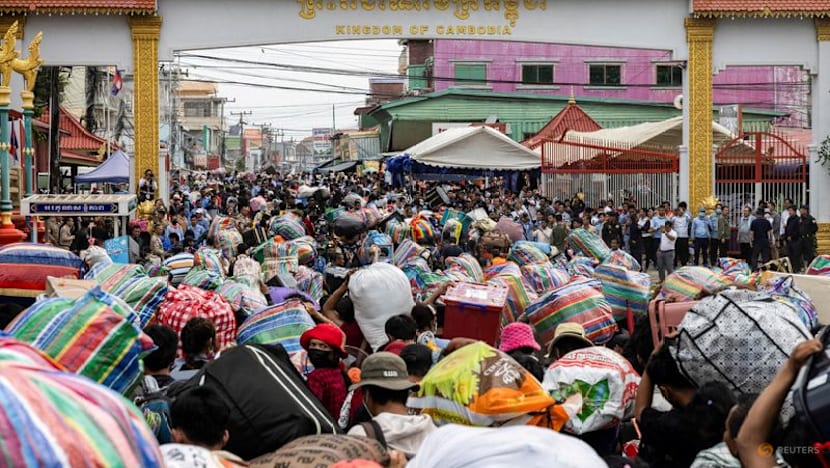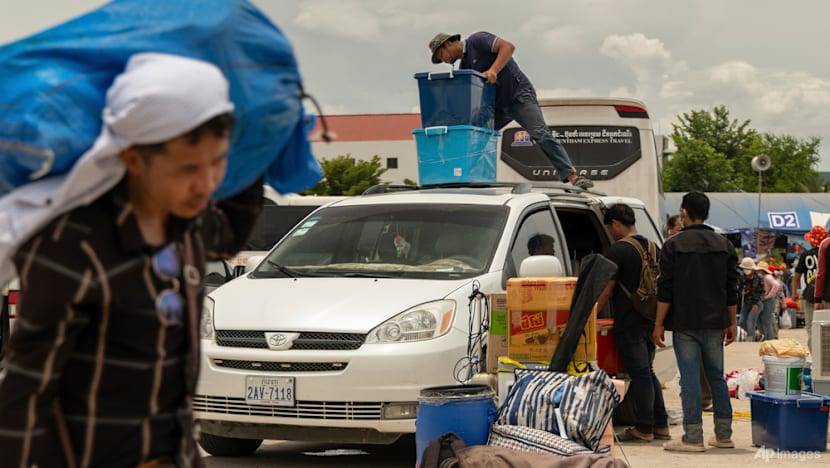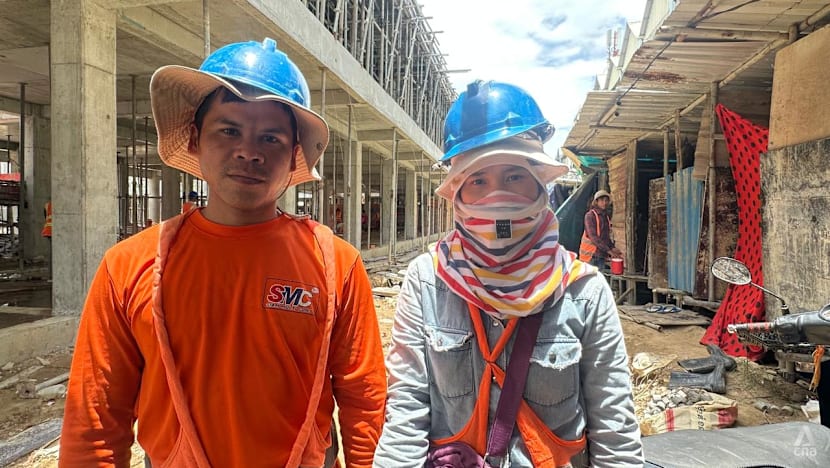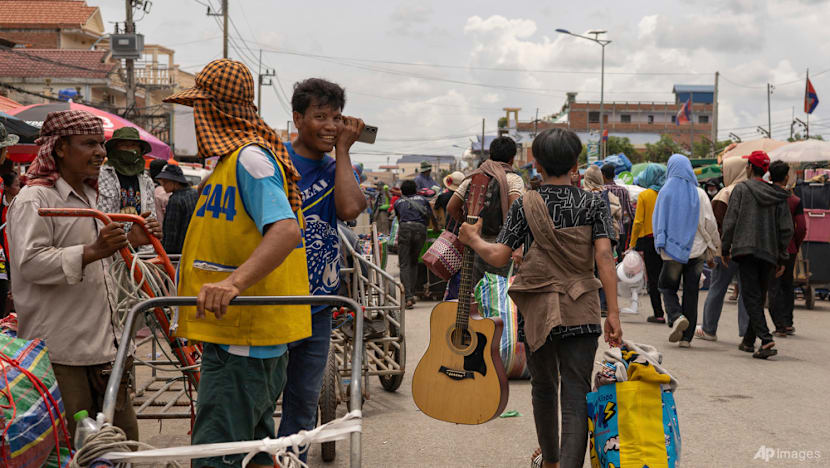‘Unprecedented exodus’ of Cambodian workers from Thailand leaves both countries reeling
Multiple Thai sectors are now missing essential workers while Cambodians contend with an economy that will struggle to provide them employment.

Cambodian migrant workers cross the border at Ban Laem Border checkpoint in Chanthaburi province, Thailand, Jul 28, 2025 to return home. (Photo: Reuters/Andre Malerba)

This audio is generated by an AI tool.
BANGKOK/PHNOM PENH: Cambodian national Ta Thavy had already been on edge for days as military clashes raged along the Thai-Cambodia border in late July.
A long-simmering border dispute between the two neighbours had erupted into the worst clashes in decades, culminating in 43 deaths and the mass displacement of people on both sides.
Pressure was mounting on Ta and her husband to leave their construction jobs in Bangkok and return to Cambodia, just like thousands of others were doing.
The couple had been in Thailand for more than a decade and, without proper immigration paperwork, taking the long and uncertain journey home would not be cheap or simple.
When violence arrived in their workers camp, however, the decision was clear.
“Three Thai people had been drinking since 5pm, and then one of them whom we knew - he's also working at the same construction site with us - came with a knife and attacked us,” she alleged.
Her husband sustained wounds to his hand and back. By 2am they were on the dark road, part of the exodus that was unfolding across the country.
With some estimates of more than a million people going from Thailand to Cambodia over a short period of a few weeks, both countries have been left with intractable labour problems.
Thailand’s shortage is Cambodia’s glut.
Multiple Thai sectors are now missing essential workers while Cambodians contend with an economy that will struggle to provide them employment.
“I don't think Cambodia is ready to absorb these people back,” said Roisai Wongsuban, an adviser for Migrant Working Group, a non-government organisation coalition based in Thailand.
Official numbers on both sides of the border differ vastly and are below those estimated by migrant groups.
On Aug 19, the Thai Ministry of Labour published in a Cabinet resolution that the unrest had led to some 22,546 Cambodian migrant workers leaving.
Five days earlier, the Cambodian National Committee for Counter Trafficking had reported 864,114 returnees.
“If undocumented workers and unreported cases are included, the total could be roughly 1.5 to 2 million people,” said Sompong Srakaew, executive director of Labour Rights Promotion Network Foundation, based in Thailand’s Samut Sakhon province.
The human wave across both countries’ border checkpoints was “unprecedented in history”, said Khun Tharo, programme manager at the Centre of Alliance of Labour and Human Rights (CENTRAL) in Phnom Penh.
There were two main factors that drove large numbers of Cambodian workers to return home, Sompong explained. Family obligations or pressures, along with feelings of insecurity from threats and harassment in Thailand that sowed panic within migrant communities.
“The situation began to spiral out of control,” he said.
Earlier in June, political heavyweights in Cambodia, including former Premier Hun Sen, had warned about the risks of remaining in Thailand as the border dispute between the two countries dragged on.
“We cannot rely on others our whole lives. We cannot stay in Thailand forever. Now is the right time. As long as the border issues remain unresolved, discrimination and insults will persist. We should return to our homeland before we are forcibly expelled,” he said in a statement.
Ta landed in the border town of Poipet in Banteay Meanchey province and took up work as a food vendor for a few weeks before quitting due to the low pay and tough work conditions. “Now, we don't have jobs and we’re still looking,” she said.
Her story is like many others: Of being caught up in a maelstrom of directives, danger and discrimination and now facing an uncertain future.

NEW WORKERS, AGE-OLD PROBLEMS?
Thailand will begin to discover what life without Cambodian workers really costs, said Roisai.
The reality is problematic for multiple sectors of the economy that have long been underpinned by cheap labour.
A joint report by the International Labour Organization (ILO) and Organisation for Economic Cooperation and Development from 2017 estimated that migrant workers contributed 4.3 to 6.6 per cent of Thailand’s gross domestic product.
Before the conflict began, over 520,000 Cambodians worked in Thailand, accounting for 12 per cent of the country's foreign workforce, according to official data.
Cambodian migrants made up the second largest group in the country before the exodus, only behind the estimated four million Myanmar nationals in Thailand.
“Without them, economic disruption could be substantial for many employers,” said Nilim Baruah, a senior regional labour migration specialist at the ILO in Bangkok.
Many migrant workers are hired to perform largely unskilled labour roles in construction, fisheries, food processing and agriculture. The export sector will feel the pinch first as production must meet orders on time, Sompong said.
The seafood industry may cope better, given the ongoing monsoon season means it is not currently the peak fishing period. For fruit farms or other crop sectors needing seasonal pickers, the impacts could be devastating, he added.
The labour shortages will have businesses scrambling for urgent replacements in a system that is inflexible and opaque.
“One option is hiring workers from neighbouring countries like Myanmar, but that process is complex and costly. This situation shows the system is still fragile and needs lasting solutions, not short‑term fixes,” he said.
The current system ties workers to a single employer, making changing jobs difficult and often illegal.
Contracts are often locked in place for several years, removing flexibility for individuals and employers alike while broker fees and document fees can make finding and securing new workers expensive and time-consuming.
The idea of recruiting Thai workers to replace migrant labour can only go so far. Thai workers usually have other options and would not take on “3D” (dirty, dangerous, demanding) jobs unless the pay is much higher, Sompong said.
Last month, Thailand’s Cabinet greenlit the hiring of 10,000 Sri Lankan workers to fill the urgent labour gaps. More than 30,000 Sri Lankans quickly registered for the scheme, Labour Minister Pongkawin Jungrungruangkit told reporters on Aug 19.
He also called for workers from Nepal, Bangladesh, Indonesia and the Philippines to apply to work in Thailand.
A lack of transparency about this rushed policy has Roisai concerned about the plan.
“We don't know the process. We don't know the cost. We don't see any comprehensive plan. And I don't see the government preparing anything to help the new workers integrate with society,” she said, citing support like having translations for government or essential services that these workers would need.
While people from Myanmar and Cambodia have deep social roots in Thailand built on decades of migration movement and policy development, these potential new arrivals from other countries would not.
It could also further inflame a factor at the core of the problems with Cambodian migrants - deep rooted nationalism among many Thais towards migrants in general who are increasingly blamed for domestic economic woes, even though they are performing jobs that locals do not want.
These feelings have been expressed as vitriol and hate speech and proliferated on social media, she said.
“These (local) people don't benefit directly from migrants’ economic contributions. So, when the benefits are not well distributed, it makes some people who feel like they’re suffering translate their anger to migrant workers rather than the economic structures,” she said.
“It’s nationalism that’s driven by the wariness of resource sharing. When you read deeply, a lot of it is driven by economic hardship.”
Hostility on social media targeting Cambodian communities has been rife during this period of conflict, experts told CNA.
While Cambodians have borne the brunt in recent months, Myanmar migrants have also been repeatedly targeted in campaigns documented in recent years.
Fast spreading misinformation online was observed as a trigger for the harassment and intimidation of many Cambodian migrants during this crisis, including women and children, said Jomtien Jansomrag, a programme officer responsible for labour rights projects for Raks Thai Foundation.
The foundation’s reports show that even before the heavy clashes, Cambodian children who grew up in Thailand and lived in the border provinces of Chonburi, Rayong and Trat were already being harassed by groups of Thai youths, creating ill feelings and fear.
“These problems existed before, but the war and conflicts have made them worse ... When social media spreads hatred, it’s very difficult to stop,” she said.
These issues are not new; rather they are a pattern of behaviour targeting migrants that have been promulgated in recent years by shadowy political players and groups hiding with anonymity on social media, Roisai observed.
She said that where frictions used to occur more between employers and employees in the past, now it’s between the workers and their host communities fuelled by domestic economic struggles.

CAMBODIANS BURDENED BY DEBT AND, NOW, UNEMPLOYMENT
Across the border, huge numbers of Cambodians are now home but jobless and often buried deeply in debt.
Eang Sanan chose to emigrate to Thailand about 18 months ago in order to help pay back the US$10,000 she and her husband Vin Lors owed to a microfinance organisation. It is a common scenario for many in the country.
A major share of microfinance borrowings are used to repay old loans for investments in land, agricultural equipment or seeds, education and health care.
Yet to work in Thailand, Cambodian workers often need to borrow money to pay recruitment agencies, travel and documentation fees and renewal costs for work permits.
“We moved to Thailand because it was hard to make money here,” she said. They now work as construction workers in Phnom Penh's suburbs after fleeing Bangkok in late July.
Approximately 30 per cent of migrant households are classified as poor according to poverty estimates derived from household consumption data by the Cambodia Development Resource Institute (CDRI).
A similar number - 31 per cent - of Cambodian households with migrant members held loans averaging US$5,000. Their prior remittances were insufficient to even make interest payments, CDRI found.
If returned migrants are assumed to be unemployed and contribute no income while increasing household consumption, the poverty rate among migrant households could rise to around 50 per cent, the independent policy research institute reported.
On Aug 10, Cambodia’s Ministry of Labour and Vocational Training stated that there were 190,000 jobs available across the country, mostly in manufacturing and services. The vast majority were in provinces where internal migration is already high.
CDRI estimated that it means some 720,000 individuals may be left without employment.
A skills mismatch has emerged; returnees from Thai industries cannot easily slip into garment jobs, for example, where many of the job vacancies exist due to the specific skills required.
“They came back because they had no other options and decided to choose safety over an empty stomach,” said CENTRAL’s Khun.
“They didn't think about the effects of unemployment, hunger and other problems they will face yet.”
If they remain jobless without urgent support, they risk returning to Thailand for employment. This exposes them to labour exploitation and illegal border crossings facilitated by brokers, he warned.
Fewer than 40,000 Cambodian migrant workers have contracts under memorandums of understanding (MoUs) with recruitment agencies, or less than 5 per cent of the total, while only around half of workers in Thailand hold legal documents, his organisation’s data showed.
“Unemployment has become a heavy burden that may force many to migrate again in the future,” Khun said.
A representative of Top Manpower, an employment agency in Phnom Penh, told CNA it has no plans to send any workers to Thailand for at least the next two months, given how “unpredictable” the situation remained.
“We don’t want to see workers illegally crossing borders in Thailand,” said the company’s managing director, An Bunhak.
“We are not encouraging them to seek jobs in Thailand; instead, we are turning our eyes to local employment. And they have the option if they want to seek work overseas, like in Japan, Korea, Singapore and Malaysia,” he said.

For the ILO, the main concerns for returning workers will centre around reintegration, unpaid wages and missing documents. The government may also see strains on its social protection systems, Baruah said.
While economic disruption will be an issue for Thai employers, another overlooked challenge may be the sudden reduction of remittances into the country - whereby typically Cambodians send extra salary to their families at home, he added.
It raises the prospect of less money circulating in poor local communities and heightens the chance of vulnerable people making more risky choices to land work once more.
A GENERATION TO RECONCILE?
Both governments are now scrambling for fixes to the crisis.
The ILO however warns that political relations between the two countries need to stabilise before it becomes clear what bilateral steps might be possible in the labour migration sphere.
Upon re-opening of the border, a relaxation of the re-entry permission requirements for those who have otherwise valid documents would aid the return of many migrant workers, Baruah said.
Jomtien agrees, adding a concern she has is about how worker rights might be protected given they may have left without properly following normal protocols due to the circumstances of the conflict.
In the short term, the Thai government has issued two Cabinet resolutions related to Cambodian migrant workers allowing them to more easily change employers in-country and removing the requirement for them to leave the country to renew their work permit.
But reconciliation may be a long way off, given that land borders between the countries remain closed or severely restricted for routine travel, and international court proceedings over disputed areas could take years to resolve.
The terrors of war and the personal toll on individuals may not be easily fixed either, Roisai said.
“Many of them have started developing post-traumatic stress disorder and so on. It might take generations to make reconciliation between Thais and Cambodians,” she said.
It should be a trigger for Thailand to shake its dependence on its neighbours for cheap labour in risky, dirty industries that could be modernised by investing in technology instead, she said.
“It's about boosting our productivity and value chain. We are getting old and losing our workers. Now, it's about creating decent work, decent jobs.”
Many economies in both East and Southeast Asia are facing a looming crisis of ageing populations and shrinking workforces, increasing competition for labour to fill needs.
Thailand will struggle to match the salaries of more advanced economies, putting it at a disadvantage if it does not change its approach, she said.
“The minimum wage is so cheap, and that's why Thai people do not want to do these jobs. I think in the future, even many migrants, if they have a choice, will go to another country that's more economically attractive to them,” she said.
From Jul 1 this year, the daily minimum wage for workers in Thailand ranges from 337 baht (US$10.4) to 400 baht, depending on the province.
In Cambodia, Khun said the government should consider financial support packages or allow over-indebted workers to suspend repayments to microfinance institutions until they find stable jobs and can resume payments.
It should also set up a social protection programme that offers free access to healthcare at public health centres and reduces medical costs and also provide humanitarian assistance to families to meet their basic needs during this crisis, he said.
A range of other solutions, like skilled workers certificates, eliminating agency recruitment fees, investing more in human capital and reviewing the bilateral MoU on migrant labour, which dates back to 2003, could help Cambodia build a more sustainable framework for workers to return over the border - with protections and dignity - in the future, he said.
The geographic mismatch between the location of economic opportunities around major economic hubs and the origin of migrant labourers - who are typically from poorer border regions - means that facilitating internal migration within Cambodia must be a core part of the response strategy, the CDRI said.
For Ta, the former construction worker in Thailand, her ask is a little more basic but entirely overarching.
“I want peace, as in the past,” she said. “No more war.”




















